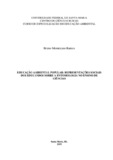| dc.contributor.advisor | Pasquali, Ísis Samara Ruschel | |
| dc.creator | Ramos, Bruno Montezano | |
| dc.date.accessioned | 2020-01-14T13:34:01Z | |
| dc.date.available | 2020-01-14T13:34:01Z | |
| dc.date.issued | 2019-08-13 | |
| dc.date.submitted | 2019 | |
| dc.identifier.uri | http://repositorio.ufsm.br/handle/1/19357 | |
| dc.description | Monografia (especialização) - Universidade Federal de Santa Maria, Centro de Ciências Rurais, Curso de Especialização em Educação Ambiental, RS, 2019. | por |
| dc.description.abstract | The research emerges as a demand for environmental education, considering the phenomenon of urban expansion that affects the municipality of Santa Maria - RS towards the crisis of modernity. The choice for the educational setting is justified by the challenges encountered in developing activities that relate science content to the problems of local reality. In front, the research was carried out in a municipal school in a peripheral neighborhood, which includes in its school community members who experience the social and environmental impacts resulting from the pollution of the Cadena Creek, daily encountering a great diversity of insects that inhabit the nearby areas. from the stream. In the centrality of the research, there is consistency in intervening in the school reality through environmental education actions in order to analyze the students' social representations about insects and highlight the importance of studying them at school, paying attention to the human-insect dynamics. environment by an ecological and intercultural approach, which enables a more integrated curriculum on this subject by problematizing learning, concerned with the reality of the students. Data collection occurred through open question forms distributed to students and theoretical and practical activities, all based on Jodelet (2001) Moscovici (2004) and Abric (2000). Data exploration was done through content analysis (BARDIN, 2016). As a result of this research, the social representations about the insects were identified, the lines were deeply analyzed, exploring their meanings, which allowed us to understand the proper language and the context in which the students are inserted. Therefore, it was possible to build alternative ways of teaching and learning in the school environment, which bring the students closer to the insects and the problems of Arroio Cadena, contributing to the improvement of these interrelations and the promotion of popular environmental education. | eng |
| dc.language | por | por |
| dc.publisher | Universidade Federal de Santa Maria | por |
| dc.rights | Acesso Aberto | por |
| dc.rights | Attribution-NonCommercial-NoDerivatives 4.0 International | * |
| dc.rights.uri | http://creativecommons.org/licenses/by-nc-nd/4.0/ | * |
| dc.subject | Insetos | por |
| dc.subject | Representação social | por |
| dc.subject | Educação ambiental popular | por |
| dc.subject | Ensino de ciências | por |
| dc.subject | Insects | eng |
| dc.subject | Social representation | eng |
| dc.subject | Popular environmental education | eng |
| dc.subject | Science teaching | eng |
| dc.title | Educação ambiental popular: representações sociais dos educandos sobre a entomologia no ensino de ciências | por |
| dc.title.alternative | Popular environmental education: social representations of education on entomology in science teaching | eng |
| dc.type | Trabalho de Conclusão de Curso de Especialização | por |
| dc.degree.local | Santa Maria, RS, Brasil | por |
| dc.degree.specialization | Educação Ambiental | por |
| dc.description.resumo | A pesquisa surge como demanda da educação ambiental, tendo em vista o fenômeno da expansão urbana que afeta o município de Santa Maria - RS rumo à crise da modernidade. A escolha pelo cenário educativo, justifica-se pelos desafios encontrados ao desenvolver atividades que relacionem os conteúdos de Ciências com os problemas da realidade local. Defronte, realizou-se a pesquisa em uma escola municipal de bairro periférico, que contempla em sua comunidade escolar, membros que vivenciam os impactos socioambientais decorrentes da poluição do Arroio Cadena, deparando-se diariamente com uma grande diversidade de insetos que habitam as áreas próximas do arroio. Na centralidade da pesquisa, há consistência em intervir na realidade escolar por meio de ações de educação ambiental no intuito de analisar as representações sociais dos educandos sobre os insetos e evidenciar a importância de estudá-los na escola, atentando para a dinâmica humanos-insetos-ambiente por uma abordagem ecológica e intercultural, que possibilita um currículo mais integrado sobre esse assunto por uma aprendizagem problematizadora, preocupada com a realidade dos educandos. A coleta de dados ocorreu através de formulários com questões abertas distribuídos aos educandos e atividades teórica e prática, todos com base em Jodelet (2001) Moscovici (2004) e Abric (2000). A exploração dos dados foi feita pela análise de conteúdo (BARDIN, 2016). Como resultado dessa pesquisa, foram identificadas as representações sociais sobre os insetos, analisou-se profundamente as falas, explorando seus significados, o que proporcionou compreender a linguagem própria e o contexto onde os educandos estão inseridos. Portanto, foi possível construir caminhos alternativos de ensino-aprendizagem no ambiente escolar, que aproximam os educandos dos insetos e dos problemas do Arroio Cadena, contribuindo para a melhoria dessas inter-relações e para a promoção da educação ambiental popular. | por |
| dc.publisher.country | Brasil | por |
| dc.publisher.initials | UFSM | por |
| dc.subject.cnpq | CNPQ::CIENCIAS HUMANAS::EDUCACAO | por |
| dc.publisher.unidade | Centro de Ciências Rurais | por |



